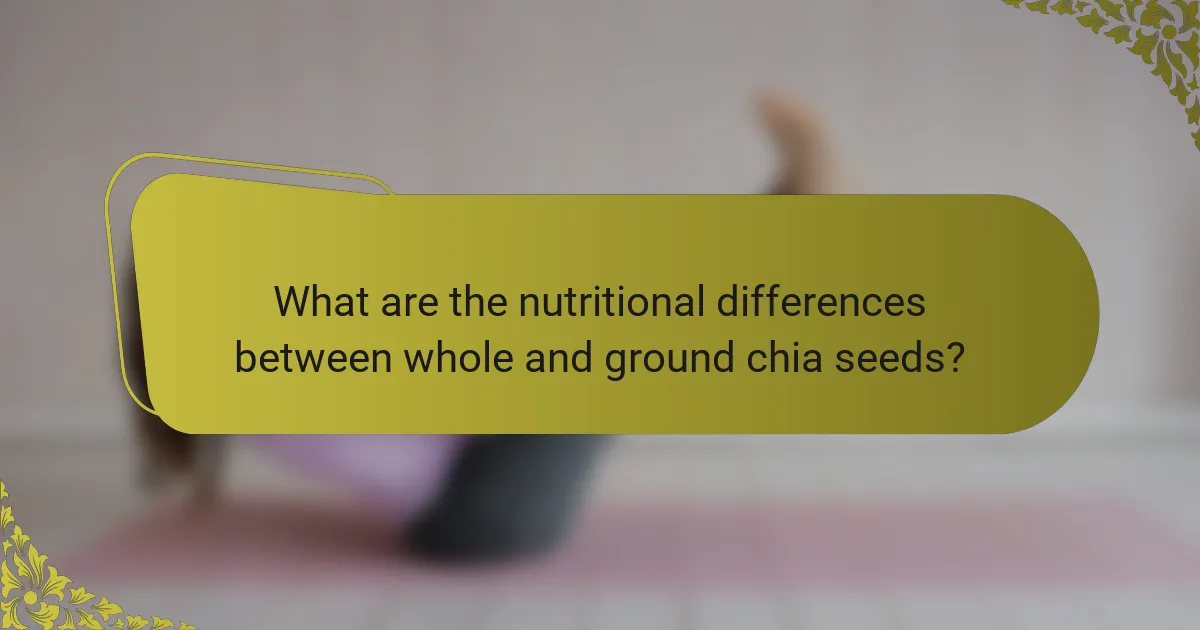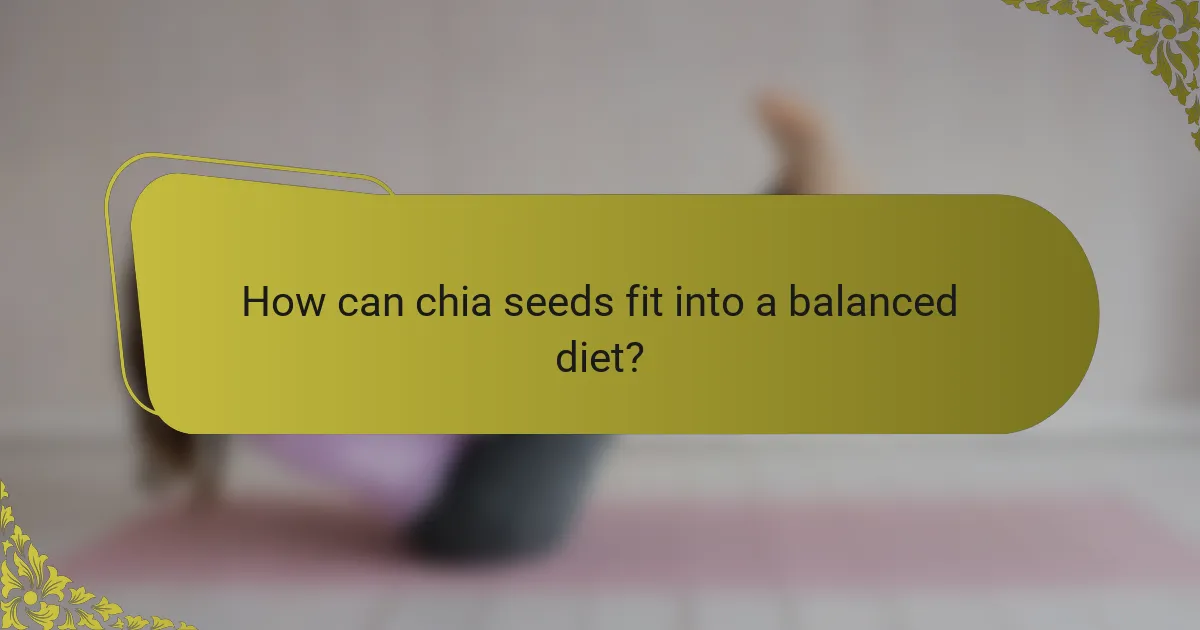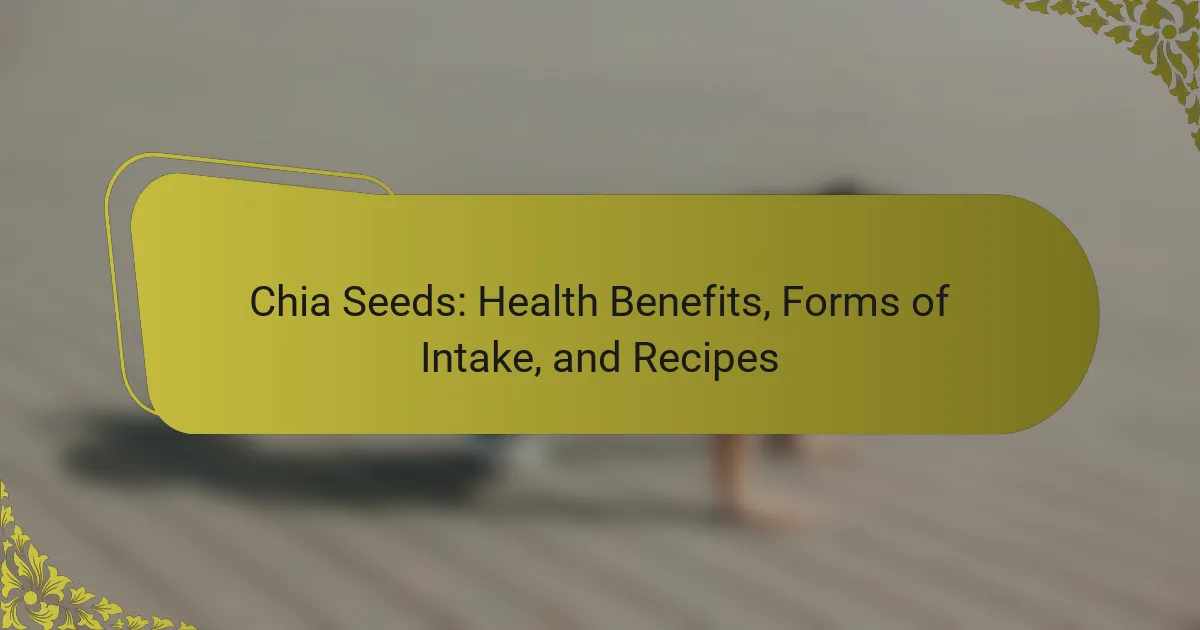Chia seeds provide significant health benefits, including high omega-3 fatty acids and fibre, supporting heart health and digestion. They can be consumed in various forms, such as whole or ground seeds, and incorporated into recipes like smoothies and energy bars. Understanding their unique attributes and optimal intake can enhance your diet and overall wellness.

What are the key health benefits of chia seeds?
Chia seeds offer numerous health benefits, including high omega-3 fatty acids, fibre, and protein content. They support heart health, improve digestion, and aid in weight management. Additionally, chia seeds are rich in antioxidants, which help combat oxidative stress. Their versatility allows for various forms of intake, such as adding them to smoothies, porridge, or baked goods.
How do chia seeds contribute to heart health?
Chia seeds significantly contribute to heart health by lowering cholesterol and blood pressure. They are rich in omega-3 fatty acids, which reduce inflammation and improve overall cardiovascular function. Additionally, chia seeds contain soluble fibre, which helps maintain healthy cholesterol levels. Regular consumption may lower the risk of heart disease.
What role do chia seeds play in digestive health?
Chia seeds enhance digestive health by providing high fibre content. They contain soluble fibre, which forms a gel-like substance in the stomach, promoting regular bowel movements. Additionally, chia seeds support gut health by acting as prebiotics, nourishing beneficial gut bacteria. Their unique attribute of absorbing water helps maintain hydration and aids in digestion.
How can chia seeds aid in weight management?
Chia seeds can aid in weight management by promoting satiety and reducing overall calorie intake. Their high fibre content expands in the stomach, helping to control hunger. A study found that chia seeds can absorb up to 12 times their weight in water, creating a gel-like substance that slows digestion. This effect can lead to decreased appetite and fewer cravings. Additionally, chia seeds provide essential nutrients, supporting overall health during weight loss efforts.
Which vitamins and minerals are abundant in chia seeds?
Chia seeds are rich in vitamins and minerals, particularly omega-3 fatty acids, calcium, magnesium, and phosphorus. These nutrients contribute to bone health, heart health, and overall wellness. Chia seeds contain approximately 18% of the recommended daily intake of calcium per ounce, making them an excellent source for those seeking plant-based calcium.

What are the different forms of intake for chia seeds?
Chia seeds can be consumed in various forms, including whole seeds, ground seeds, soaked in liquid, or incorporated into recipes. Whole seeds can be added to smoothies or yoghurt, while ground seeds can be used in baking. Soaking chia seeds in water or milk creates a gel-like consistency, enhancing their digestibility. Popular recipes include chia pudding and energy bars.
How can chia seeds be incorporated into smoothies?
Chia seeds can be easily incorporated into smoothies by adding them directly for texture and nutritional benefits. Start by blending your favourite fruits and vegetables, then mix in one to two tablespoons of chia seeds. They absorb liquid, creating a thicker consistency. For optimal results, let the smoothie sit for a few minutes to allow the seeds to expand. This method enhances the smoothie’s fibre content and provides omega-3 fatty acids.
What are the benefits of using chia seeds in baking?
Chia seeds enhance baking by providing numerous health benefits. They are rich in omega-3 fatty acids, fibre, and protein, which contribute to improved digestion and heart health. Additionally, chia seeds can act as a binding agent in recipes, replacing eggs in vegan baking. Their versatility allows incorporation into various baked goods, from breads to muffins, enriching flavour and texture. Using chia seeds in baking not only boosts nutritional value but also adds a unique crunch.
How do you prepare chia seed pudding?
To prepare chia seed pudding, combine 1/4 cup of chia seeds with 1 cup of milk or a milk alternative. Stir well to prevent clumping and let it sit for about 10 minutes. Stir again to ensure even consistency, then refrigerate for at least 2 hours or overnight. Serve chilled, optionally sweetened with honey or topped with fruits and nuts. This method highlights chia seeds’ unique attribute of forming a gel-like texture when hydrated.
What are innovative ways to use chia seeds in salads?
Chia seeds can enhance salads in various innovative ways. Incorporate them as a crunchy topping, mix into dressings for added texture, or use them to create a nutrient-rich gel that can bind ingredients together.
1. As a topping: Sprinkle chia seeds on top of salads for added crunch and nutrition.
2. In dressings: Blend chia seeds into salad dressings to create a thicker consistency and boost health benefits.
3. Chia gel: Mix chia seeds with water to form a gel, then incorporate it into salads for added moisture and binding.
4. In marinades: Use chia seeds in marinades for vegetables before adding them to salads to enhance flavour and nutrition.
5. With fruits: Combine chia seeds with fruits in salads for a refreshing twist and additional fibre.

Which recipes highlight the versatility of chia seeds?
Chia seeds can be used in various recipes, showcasing their versatility. Popular options include chia pudding, smoothies, energy bars, and baked goods. Chia pudding combines chia seeds with almond milk and sweeteners, creating a nutritious breakfast. Smoothies benefit from chia seeds’ thickening properties while adding fibre. Energy bars made with chia seeds provide a healthy snack option, and baked goods gain moisture and nutrition when chia seeds are incorporated into the batter.
What are some popular breakfast recipes featuring chia seeds?
Chia seeds are popular in breakfast recipes for their nutritional benefits and versatility. Here are some popular recipes featuring chia seeds:
1. Chia Seed Pudding: Combine chia seeds with almond milk and sweetener, refrigerate overnight, and top with fruits.
2. Chia Seed Smoothie: Blend chia seeds with spinach, banana, and yoghurt for a nutrient-packed drink.
3. Chia Seed Porridge: Stir chia seeds into cooked porridge for added fibre and texture.
4. Chia Seed Jam: Mix chia seeds with mashed fruits and a sweetener to create a healthy spread.
5. Chia Seed Pancakes: Add chia seeds to pancake batter for a nutritious twist on a classic breakfast.
How can chia seeds enhance snack options?
Chia seeds can significantly enhance snack options by adding nutritional value and texture. They are rich in omega-3 fatty acids, fibre, and protein, making them a healthy addition to various snacks.
Incorporating chia seeds into snacks can improve satiety, helping to curb hunger between meals. They can absorb liquid, forming a gel-like consistency, which can be used in smoothies, puddings, and energy bars. For example, chia seed pudding can be a delicious and nutritious snack option.
Chia seeds are versatile and can be added to yoghurt, porridge, or baked goods. Their unique attribute of forming a gel when hydrated allows for creative recipes, such as chia seed jam, which provides a healthier alternative to traditional spreads.
What are unique dessert recipes that use chia seeds?
Unique dessert recipes using chia seeds include chia seed pudding, chia seed jam, chia seed brownies, chia seed cookies, chia seed parfaits, and chia seed energy balls. These recipes leverage the unique texture and nutritional benefits of chia seeds, offering a healthy alternative to traditional desserts.

What are the nutritional differences between whole and ground chia seeds?
Whole chia seeds and ground chia seeds differ primarily in nutrient absorption and availability. Ground chia seeds offer higher bioavailability of nutrients, making them easier to digest and absorb. Whole seeds provide fibre and healthy fats but may pass through the digestive system largely intact, limiting nutrient absorption.
| Attribute | Whole Chia Seeds | Ground Chia Seeds |
|————————–|————————-|————————–|
| Fibre Content | High | High |
| Omega-3 Fatty Acids | Present | Present |
| Protein | 4 g per 28 g serving | 4 g per 28 g serving |
| Nutrient Absorption | Lower | Higher |
| Recommended Intake | 1-2 tablespoons | 1-2 tablespoons |
| Usage | Topping, hydration | Smoothies, baking |
How does the form of chia seeds affect their digestibility?
The form of chia seeds significantly affects their digestibility. Whole chia seeds may pass through the digestive system largely intact, while ground chia seeds are easier to digest and allow for better nutrient absorption. Soaking chia seeds in water or other liquids before consumption enhances their digestibility by forming a gel-like consistency, which aids in breaking down the seeds during digestion.
Which form is more beneficial for nutrient absorption?
Soaking chia seeds in water or other liquids enhances nutrient absorption. This method activates their gel-forming ability, making nutrients more bioavailable. Ground chia seeds also improve absorption due to increased surface area. Whole seeds may pass through the digestive system without full nutrient uptake.

What common mistakes should be avoided when using chia seeds?
To avoid common mistakes when using chia seeds, ensure proper hydration, avoid excessive consumption, and store them correctly.
First, always soak chia seeds in water or another liquid before consumption to enhance digestibility and nutrient absorption. Second, limit intake to about 1-2 tablespoons daily, as excessive amounts can lead to digestive issues. Lastly, store chia seeds in a cool, dry place to maintain their freshness and prevent spoilage.
How can improper preparation affect the benefits of chia seeds?
Improper preparation can diminish the health benefits of chia seeds. When not soaked or prepared correctly, these seeds may not fully hydrate, leading to reduced nutrient absorption. Additionally, consuming them dry can cause digestive issues, as they absorb liquid in the digestive tract. Proper preparation enhances their omega-3 fatty acids, fibre, and antioxidants, maximizing their health benefits.
What are the best practices for storing chia seeds?
Store chia seeds in a cool, dry place in an airtight container to maintain freshness. Exposure to light and moisture can degrade their quality.
For optimal storage, consider these practices:
– Keep them in a dark pantry or cupboard.
– Use glass or plastic containers that seal tightly.
– Label containers with the purchase date to track freshness.
Chia seeds can last up to two years if stored properly, retaining their nutritional benefits.
Which misconceptions about chia seeds should be clarified?
Common misconceptions about chia seeds include the belief that they are a miracle food or that they can replace all nutrients. Chia seeds are nutritious, but they should complement a balanced diet. Some think they must be ground to be beneficial; however, whole seeds are also effective. Others assume they are solely for weight loss, overlooking their broader health benefits, such as heart health and digestive support. Lastly, many believe chia seeds require extensive preparation, while they can be easily added to various dishes without much effort.

How can chia seeds fit into a balanced diet?
Chia seeds can enhance a balanced diet by providing essential nutrients and versatility. They are rich in omega-3 fatty acids, fibre, and protein, promoting heart health and digestive wellness.
Incorporating chia seeds is easy; they can be added to smoothies, yoghurt, and baked goods. A unique attribute of chia seeds is their ability to absorb water, expanding to create a gel-like texture, which can be used as a thickening agent in recipes.
For optimal health benefits, consume approximately 1-2 tablespoons daily. This intake supports hydration and nutrient absorption.
What are the recommended daily intake amounts for chia seeds?
The recommended daily intake of chia seeds is 1 to 2 tablespoons, which provides essential nutrients. This amount supports health benefits such as improved digestion and heart health. Chia seeds are rich in omega-3 fatty acids, fibre, and protein, making them a valuable addition to a balanced diet.
How can chia seeds complement various dietary preferences?
Chia seeds can enhance various dietary preferences due to their versatility and nutritional profile. They are rich in omega-3 fatty acids, fibre, and protein, making them suitable for vegan, vegetarian, and gluten-free diets.
For vegans, chia seeds serve as a plant-based source of essential nutrients. In gluten-free diets, they act as a binding agent in recipes. Additionally, chia seeds can be incorporated into smoothies, baked goods, and salads, providing texture and health benefits.
Their unique ability to absorb liquid and form a gel makes them a popular choice for puddings and as an egg substitute in vegan baking. This adaptability allows chia seeds to complement diverse culinary styles while supporting health and wellness goals.
What expert tips can enhance the use of chia seeds in meals?
To enhance the use of chia seeds in meals, consider these expert tips. Soaking chia seeds in water or milk before use improves digestibility and texture. Incorporating them into smoothies adds thickness and nutritional value. Use chia seeds as a thickening agent in soups or sauces for added health benefits. Additionally, sprinkle them on salads or yoghurt for a crunchy texture and omega-3 fatty acids.
